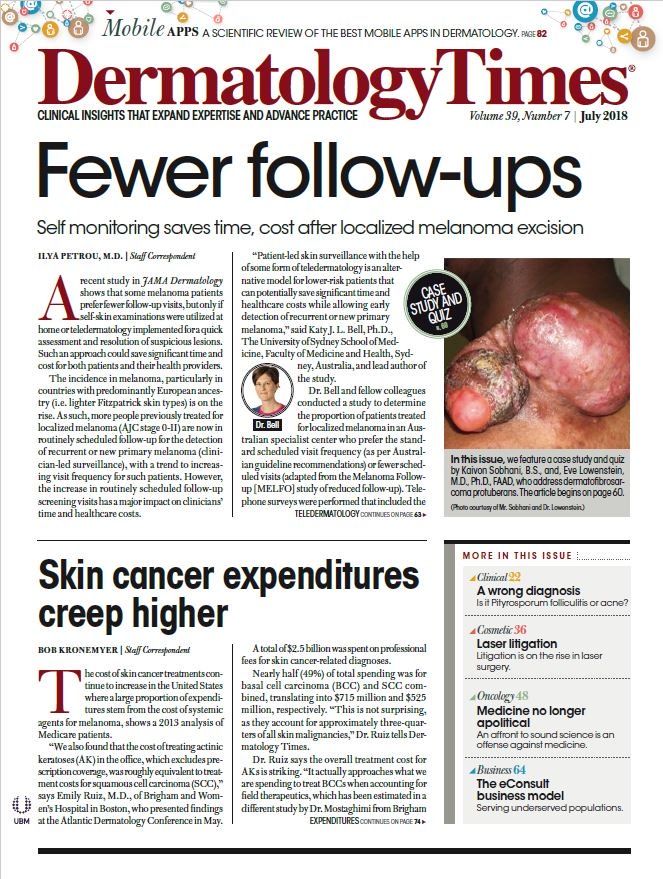- Acne
- Actinic Keratosis
- Aesthetics
- Alopecia
- Atopic Dermatitis
- Buy-and-Bill
- COVID-19
- Case-Based Roundtable
- Chronic Hand Eczema
- Chronic Spontaneous Urticaria
- Drug Watch
- Eczema
- General Dermatology
- Hidradenitis Suppurativa
- Melasma
- NP and PA
- Pediatric Dermatology
- Pigmentary Disorders
- Practice Management
- Precision Medicine and Biologics
- Prurigo Nodularis
- Psoriasis
- Psoriatic Arthritis
- Rare Disease
- Rosacea
- Skin Cancer
- Vitiligo
- Wound Care
Publication
Article
Dermatology Times
Revised melanoma staging criteria
Staging system is derived from a new dataset of patients from 10 cancer centers around the world. Dermatologists should consider AJCC tumor characteristics as well as other factors in risk assessment, counseling, and follow-up plans for patients. Update takes effect in January 2018.
The American Joint Committee on Cancer (AJCC) has published the 8th edition of its Melanoma Staging System, and it will take effect January 1, 2018.
Dermatologists should be aware that the update contains revisions pertaining to the patients they care for with melanoma, but also understand other variables not included in the AJCC system in order to refine individual management plans, Michael E. Ming, M.D., MSCE told colleagues the 2017 Summer AAD Meeting.
RELATED: Melanoma staging criteria
“AJCC staging is based on analyses of melanoma-specific survival data that help us understand which patients are at higher risk of dying from their disease,” said Dr. Ming, associate professor of dermatology, University of Pennsylvania, Philadelphia.
“However, the system is purposefully simple to enable usability around the world. It can only include information that all pathologists can determine, and it does not capture all of the factors that have been demonstrated to be associated with survival. Furthermore, there are other issues that affect management decisions, such as who should undergo a sentinel lymph node procedure and who is more likely to have a second primary melanoma. The risk factors associated with those outcomes are not exactly the same as those associated with survival, which is the only outcome of interest taken into account in the AJCC staging system.”
AJCC staging revisions
The key change in AJCC staging for melanoma confined only to the skin at the time of diagnosis pertains to Stage I melanomas and involves modification of the criteria for subcategorizing T1 tumors. The new staging system eliminates mitotic rate from the T1 staging criteria and subcategorizes these lesions further by tumor thickness: T1a tumors are defined by thickness <0.8 mm with no evidence of ulceration, and T1b tumors include lesions that are <0.8 mm in thickness with ulceration or ≥0.8 to 1.0 mm in thickness with or without ulceration.
“Compared with the current version, the new staging system is derived from a new dataset of patients from 10 cancer centers around the world, and for the first time, only includes patients seen in the era after widespread use of sentinel lymph node biopsy,” Dr. Ming says.
“Although the members of the expert panel that designed the new system felt that a cutoff of 0.8 mm for thickness was a better risk stratification factor than mitotic rate for thin melanomas, mitotic rate was not eliminated because data showed that it was no longer related to lower survival. The AJCC continues to recommend that mitotic rate be assessed. Mitotic rate is still important for predicting survival for patients with Stage I melanoma and something that I will continue to use in practice when making a risk assessment.”
The new system also includes a recommendation to report lesion thickness to a single decimal place rather than two. With the new recommendation, both a lesion that is 0.65 mm thick and one that is 0.74 mm thick would be reported as 0.7 mm.
Fine-tuning care
Although the AJCC staging system does an excellent job in risk stratification of melanoma patients by survival, dermatologists should also be aware of other variables that have significance in other endpoints and consider them in their risk assessment, patient counseling, and follow-up plans, Dr. Ming says.
In addition to tumor characteristics such as thickness, ulceration, and mitotic rate that are included in the AJCC staging system, patient characteristics such as patient sex and age have also been demonstrated to be associated with differences in survival. Given similar tumor characteristics, men do worse than women, and older people are at risk for a worse outcome than younger individuals. Anatomic location of the melanoma is also important, with axial lesions having a worse prognosis than those found on the extremities. In addition, there are a number of microscopic characteristics that portend a poorer prognosis for survival, including vertical growth phase, regression, absence of tumor-infiltrating lymphocytes, and lymphovascular invasion.
Dr. Ming told attendees that he and colleagues at the University of Pennsylvania have developed a more complex risk stratification system to help guide patient care. Their system incorporates six tumor characteristics-vertical growth phase, thickness, mitotic rate, tumor-infiltrating lymphocytes, regression, and ulceration-along with patient sex, age, and body site to create a risk stratification system that is used in their clinic in parallel to the AJCC system.
“Our system stratifies patients into three risk groups, and higher risk patients get more frequent follow-up examinations and may also get screening imaging,” Dr. Ming says.
He added that risk factors for a second primary melanoma, such a strong family history of melanoma, also need to be taken into account when deciding frequency of follow-up visits and finalizing a management plan.

Newsletter
Like what you’re reading? Subscribe to Dermatology Times for weekly updates on therapies, innovations, and real-world practice tips.





























